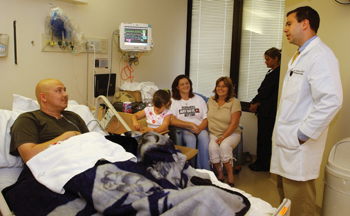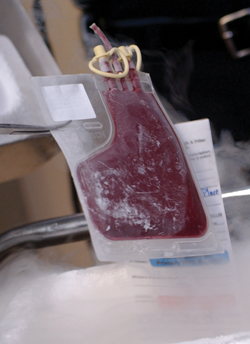
Patient Charles Dougherty talks with Brian Engelhardt, M.D., before his umbilical cord blood stem cell transplant last week, as his family looks on.
Photo by Dana Johnson
Transplant gives soldier fighting chance

Umbilical cord blood stem cells were transplanted into patient Charles Dougherty last week.
Photo by Dana Johnson
Charles Dougherty has become the first patient of Vanderbilt’s adult transplant team — and only the second adult in Tennessee history — to receive a stem cell transplant from umbilical cord blood, offering him a fighting chance at beating leukemia.
Madan Jagasia, M.D., and Brian Engelhardt, M.D., specialists in hematology and stem cell transplant at the Vanderbilt-Ingram Cancer Center, performed the procedure last week. The only distinguishing characteristic Dougherty, 24, and his doctors know about the donor blood is that it was from a female baby. After the transplant, Dougherty will have blood characteristics of the donor.
“He will have female DNA in his bone marrow and in his circulating white blood cells,” said Engelhardt. “We can measure the XX chromosome, then you know his blood is now 100 percent donor, and that's what we'd be going for,” added Engelhardt.
Cord blood transplants have been widely used to treat children with blood-borne cancers but the procedure is still new in adult patients because of the amount of stem cells needed for a larger patient. Jagasia said the techniques needed to safely carry out the cord blood transplant have also improved. “We've gotten better at freezing, transporting and collecting cord blood.”
Dougherty, a husband and father of three girls, said he was surprised when he found out he had an advanced blood cancer less than a year ago. But a biopsy of the lymph nodes in his neck tested positive for the disease and he's been on a roller coaster with cancer ever since.
Dougherty is a combat engineer for the U.S. Army stationed at Fort Campbell, Ky., in the Alpha company's first brigade and special troops battalion.
“I went back to work for a while, but I got an infection and had to be hospitalized,” he said. He spent 45 days in the hospital for initial chemotherapy to treat the disease. The soldier said he's ready to be done with this fight and get back to work.
“Used to, when they told you, 'you have cancer,' it was pretty much over. Now they can pretty much cure everything,” Dougherty said. “It's pretty nifty. It's very advanced,” he added.
Before the transplant could happen, Dougherty had to go through powerful doses of chemotherapy and radiation for a week to rid his body of any cancer that might be hiding elsewhere in his blood, which could ruin the chances of a successful transplant. While Dougherty was being prepared for transplant, the cord blood was flown in from a blood bank in New York. It arrived frozen in liquid nitrogen before being warmed at Dougherty's bedside and placed in a syringe.
The transplant itself is fairly simple — an IV line is placed under the collarbone and the stem cells are pumped in to do their work.
“These cells are smart. They home to the bone marrow — how, we don't know. They only go to the bone marrow,” Jagasia said.
Dougherty was given medications and will now be watched closely for something called graft versus host disease (GVHD), rejection of the recipient's body by the donor's cells, which the doctors said happens 6 percent to 8 percent of the time.
“Charles will basically have someone else's immune system,” Jagasia explained.
Engelhardt said the next four to six weeks will be crucial for Dougherty.
“We'll be looking for recovery of his bone marrow and for the white blood cells to come back, meaning a return of his infection-fighting cells,” said Engelhardt. Dougherty will be at a high risk for infections and other problems associated with stem cell transplant.
The cord blood has been put through rigorous testing and has proven to be a match for Dougherty, with enough stem cells for his body weight. Only time will tell if this will prove to be a cure for his cancer.
“In the next three to six months we should know if his cancer is going to come back,” said Engelhardt. As far as getting back to work with his fellow soldiers in the Army, that could still be in question.
“It would be our hope that we would know in about a year, but it's just too early to tell,” added Engelhardt.
Jagasia encouraged others to consider cord blood donation, which can be done through one of three certified banks in the United States. For more information about donating cord blood visit: www.cryo-intl.com/enroll.html.













